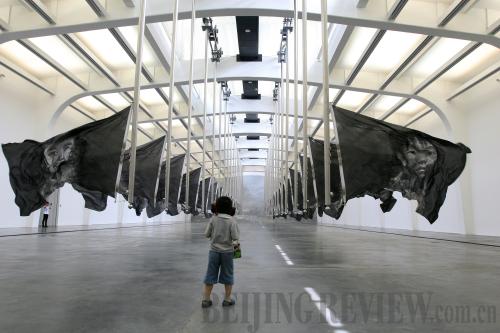|
 |
|
LANDSCAPE OF CHILDHOOD: The Ullens Center for Contemporary Art (UCCA) in Beijing's 798 Art Complex presents Landscape of Childhood, a piece of installation art by artist Yan Peiming this summer (CNSPHOTO) |
A new term to most of China's urban residents, public art has already created an appealing first impression by way of sculptures in parks and plazas and frescos at airports and libraries. Increasing numbers of Chinese artists are now becoming involved in the creation of public art projects, despite the fact that quite a number of viewers don't enjoy them.
Last spring, the depiction of 20-odd realistic naked and disfigured sculptures by farmer-sculptor Yu Qingcheng in a garden of Beijing's super-large community, Tiantongyuan, triggered disputes over whether it was art or vulgarity. On its heels, a sturdy naked statue staring down at a disfigured and shriveled image of Lao Zi in front of Peking University's Guanghua School of Management has stirred controversy among faculty and students since November 2008, making them wonder about a seemingly ridiculous juxtaposition.
"The works themselves are fine and decent, but they were installed in the wrong places," Qin Pu, a sculptor and Director of the Public Art Studio of the Central Academy of Fine Arts (CAFA), told Beijing Review.
"Each piece of public art serves a particular public space and the people who live, work or move around in the special space," Qin said. "That's why artists should first grasp the essence of the space as well as the common values of the people active in it."
Public art is difficult to create because, in many instances, it is difficult for an artist to define the environment and the people's varied interests and tastes, says Qin. Still, he argued, it should be the joint efforts of designers and artists as well as any sponsor to find appropriate works to fit public spaces of varing atmospheres.
But, in the digital age, still-life paintings or sculptures sometimes no longer satisfy changing tastes for art. Artists are experimenting with all kinds of instruments and materials to create works in various forms and reflecting huge changes in modern China ,such as urbanization and the Internet mania.
"Whatever the materials or forms, a good piece of artwork in a public space is not necessarily the one you see, but always the one you feel and are emotionally connected to or inspired by," Qin said.
For the people
Public art reflecting on time and space is a way for artists, with their wisdom and creativity, to embody the spirit of an age and influence mainstream values, but ultimately it's for people to enjoy, Qin said.
In the case of the Tiantongyuan sculptures, although the property developer himself likes Yu's works, many residents do not.
"These statues seem irrelevant and do not match the environment, probably because the swollen, disfigured works were initially designed as desk decorations. Also, once they were enlarged, exaggerations were magnified beyond what people can bear," Qin said.
Similarly, the juxtaposition of the two statues at Peking University, respectively interpreted by the authors as "knowledge, the symbol of power" and "Lao Zi showing his teeth and tongue to represent harmony between firmness and gentleness," doesn't make sense, said Qin.
In both cases, the property developer or real estate service provider may be responsible for underestimating public taste or incongruity, but the artists, having undergone professional training, should have better ideas about placement of their work, said Qin.
| 